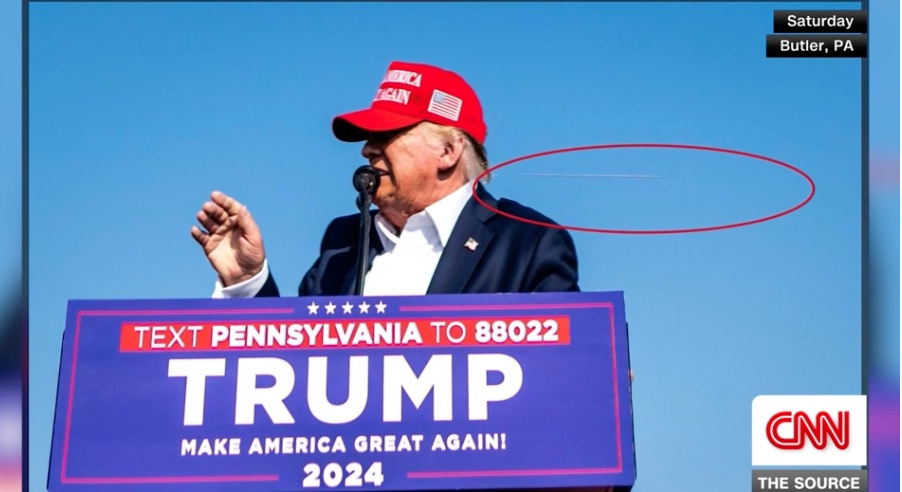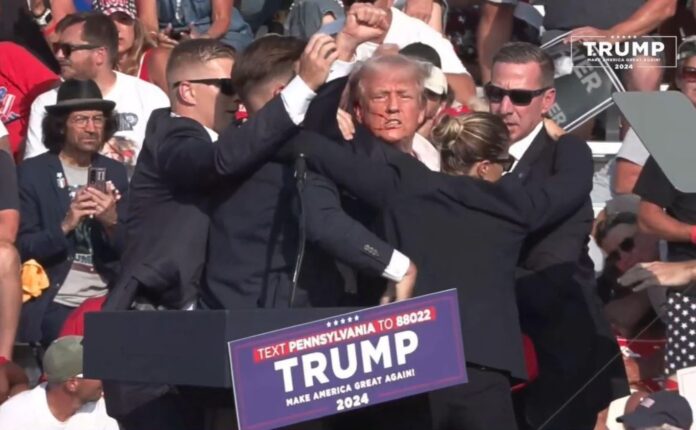Although a widely circulated news photograph shows the astounding moment a bullet whizzed by Donald Trump’s head on July 13, while he spoke at a rally in Butler, Penn., the head of the Federal Bureau of Investigation cast a doubt on whether that bullet actually struck the edge of Trump’s ear. It could have been something else, said Christopher Wray to the House Judiciary Committee.
“With respect to former President Trump, there’s some question about whether or not it’s a bullet or shrapnel that hit his ear,” Wray said. “I don’t know right now whether that bullet, in addition to causing the grazing, could have landed somewhere else.”
He did not say what kind of shrapnel could have hit Trump’s ear, while some Trump opponents have speculated that it could have been glass from the teleprompter. That theory has been dismissed by the liberal fact-checking site Snopes.
A photo, taken by Pulitzer Prize winning photographer Doug Mills from his vantage point beneath the stage, shows a bullet passing by Trump’s ear.

Wray confirmed that the F.B.I. has recovered eight casings of bullets. On Tuesday, Pennsylvania State Police Commissioner Christopher Paris said that the assassin, now dead, had fired eight shots.
Wray said that the gunman may have had a firearm with a collapsible stock, which would make it easier for him to carry the weapon unnoticed. But Wray gave no reason for why he was not stating this definitively, since the weapon was found with the gunman, Thomas Crooks, on the roof.
On July 5, Crooks, 20, had visited the site of the upcoming July 13 rally in Butler, according to Wray, and that he had researched online information about the assassination of John F. Kennedy, including searching for the phrase “how far away was Oswald from Kennedy.” Lee Harvey Oswald is the man who is blamed for killing President Kennedy in 1963.
After researching those terms, Crooks then registered for the rally. On the morning of the rally, Crooks went to the site in Butler, and then left in the afternoon to buy 50 rounds of ammunition, Wray testified.
Wray, whose agency is in charge of the investigation, also said that Crooks had purchased a ladder, according to a blood-soaked receipt that was found on his dead body after snipers took him out. But Wray said no ladder was found at the scene and he doesn’t know how Crooks got up on the roof of the building that gave him a clear shot at Trump.
Crooks was documented back at the rally site just before 4 p.m. on July 13, when he flew a drone within 200 yards of the stage where Trump would be speaking at about 6 pm. The F.B.I. found the drone in Crooks’ car, along with a drone controller and two explosive devices that could have been remotely detonated. Crooks had a transmitter as well for the devices, Wray said.
Other testimony from the Pennsylvania State Police has shown that the Secret Service was alerted to Crooks’ presence on the ground with a rangefinder at 5:51 p.m.
At 5:52 p.m., the Secret Service shared the information about the suspicious person with the rangefinder.
At 6:03 p.m., Trump took the stage at Butler.
At 6:09 p.m., people in the area started shouting about the man on the roof with the gun. One officer tried to get up on the roof, but retreated when Crooks turned his gun on him.
One video, shot at 6:11:28 p.m. show people shouting and fleeing after they spot the gunman.
The shots were fired at 6:11:33 p.m., killing one man behind Trump and wounding two others, plus the minor wound to Trump’s ear.
Wray was more forthcoming in his testimony than was Secret Service Director Kimberly Cheatle, who testified on Monday and then resigned her office after her testimony was widely criticized as disingenuous and evasive.

Wray is taking the opportunity to cast doubt that Trump was actually grazed by a bullet. Of course he doesn’t give any possibilities of where that ‘shrapnel’ would have come from. Downplays the notion that Trump was really in THAT MUCH danger. Wray was trotted out to mitigate the disastrous ‘testimony’ of the former Secret Service Director. He appeared ‘folksy’, soothing and trying to be helpful. Not appearing to hide behind the ‘on-going investigation’ smoke screen. All without really saying much of anything. So the ‘investigation’ will grind on for a few months with the intention that public interest will evaporate. A report will then come out blaming the troubled 20-year old and that the Secret Service could have done better but that they will work hard to improve. After all, the Director of the SS lost her job! Case closed. Easy peasy.
No mention of how many shell casings they recovered, and from where. Ballistic analysis lends to 10, maybe eleven rounds fired, and from three different locations.
The Wray testimony was meant to make President Trump seem not so heroic.
Close, Randall. It’s meant to cast doubt on the fact that the FBI secretly directed a hit on Trump. A 20-year old male without social media accounts? Triangulated communication pings off Crook’s cellphone to a location quietly known as an FBI field office?
C’mon man!
Wonder if Wray is hedging his bets hoping to stay under Kamala?
One of the reasons I’m voting Trump is to see him perform an enema on the FBI.
Starting with Wray.
Under Kamala? I heard that she prefers bottom.
The Warren Commission’s “magic bullet” theory rides again. If Wray believes that shrapnel or some other object hit Trump’s ear, he needs to have evidence to back it up. Wray’s comments further tarnish the FBI’s already troubled reputation.
I guess we can call this the no bullet theory. The Magic Ear Piercing Technique that died with Mr. Crooks.
Bullet denier. Is that anything like an election denier?
FBI leadership full of commies and American traitors. Liars. Keystone Cops. The FBI should be dissolved by Trump and traitors like Comey and Wray put in prison. Dirty cops, to the core.
One thing we can always count on is Democrat incompetence. They tried smear campaigns, impeachments, kangaroo NY courts, and an assasination attempt. Failed at all.
Inside job. Multiple agencies.
No other explanation.
Agree. No other explanation for the sloppy work at close range. There was probably another shooter, to kill the kid in case he missed. Where did he get the idea and plan? Too open, too close.
Wray is a plain old ordinary lying crook,only wearing a badge
A dirty federal cop.
Ramaswamy says as much also; he wanted to eliminate the FBI and let the Marshall Service take over the functions; the kind of leadership we need. FBI agent Strzok, what a horrible leftist criminal… using his position to attack Trump solely for political purposes.
After many days of analyzing audio, video and photographic evidence of the attempted assassination of President Trump, I cannot currently find any evidence whatsoever to support the notion that Crooks fired any shots at all. There is overwhelming evidence, however, in support of the idea that he was a patsy. The rifle was found 7+ feet away from his body. How did it get there if he was shot dead? Dead men don’t move rifles around. It’s clear the rifle was not in his hands when he was shot. No brass locations were apparently marked on the roof by the FBI or anyone else, and there are no brass casings present in the police body cam footage taken from the roof shortly after the shooting. Thus, we have zero evidence of any spent brass on the roof at all. The “crime scene” behavior and protocols by SS and LEOs is absolutely atrocious, as if they didn’t even consider it a real crime scene at all. The sniper named “Greg” in the second floor office of an adjacent building had a clear, open view of Crooks on the roof, yet did nothing to stop him, even after photographing him. The TMZ video showing Crooks at the very moment the first 3 rounds are fired shows NO RECOIL, no muzzle flash, and no brass ejecting from the right side of the rifle. How did Crooks fire a rifle with no recoil? The 1X optic or iron sights on the rifle also would have made it extremely difficult for Crooks to make a head shot with any sort of accuracy (without magnification). Furthermore, how did Crooks manufacture explosive devices that we are told were found in his car? Where would he have acquired such technical expertise to work with explosives without blowing himself up? Why was he allowed to fly a drone over the speaking location several hours before the event? Why was he allowed to use a rangefinger to range the podium location without being detained and questioned about his intentions? Why was he filmed walking around the grounds with no concern at all, almost as if he believed he was there with permission? (Training mission narrative.) How did he know this particular roof would not be covered by Secret Service? Who told him the roof was available to him? What seems to be emerging, in my view, is that Crooks believed he was on a training mission, working WITH law enforcement to determine vulnerabilities, and he was playing along as they told him things like, Here, take this rifle and climb onto that roof and tell us what you see. He did as he was told, put himself in position and then potentially somebody else took all 8 shots, after which Crooks was killed to wrap up the cover story. Although not yet provable – and perhaps never provable – this is emerging as a more likely explanation that fits the available data we have so far. It’s subject to change, of course, if new data points emerge, so I reserve the right to update or alter this analysis based on new data. Keep your thinking caps on. Keep crowdsourcing this investigation. The FBLie is now engaged in an active cover-up.
Wray is a criminal leading a criminal organization – which is one of the enforcement mechanisms of the oligarchs. Like all secret police he focuses on regime compliance and maintaining institutional power. Truth and justice is not a part of his purview.
Wray is among the worst people in American public life.
Photos show no damage to the teleprompters AFTER Trump was hit:
‘https://www.usatoday.com/picture-gallery/news/politics/2024/07/13/trump-rushed-off-stage-by-secret-service-at-pennsylvania-rally/74396190007/
We’ve gone from JFK’s “magic bullet” to Trump’s “magic shrapnel” theory. Same old story, told by same old liars.
Deep State.
Wray is uncharacteristically spewing out information, to insure that the usual “lone gunman” narrative remains alive and well.
Wray went all-in for Harris, because he knows Trump can’t wait to fire him on Jan 20. This absurd shrapnel claim, in spite of all the evidence to the contrary, was obviously intended as a snipe against Trump, and was designed to bolster his future CNN/MSDNC talking-head consultant rates.
Fire him, He is a criminal.
What’s the line from the song?
Oh yeah…
Paranoia strikes deep.
Sad. Really, really sad.
Director Wray’s speculation is irresponsible. There are comments above that I would never have believed ten years ago. Things have changed. It is now more likely than not that people drawing government paychecks are not working for the citizens but rather for their own or other interests. These Deep State actors may populate agencies like Homeland Security, the CIA and the FBI. They are experts at planting false information and creating narratives to serve ends they favor.
Director Wray knew exactly what he was saying. Unless these bad actors are identified and removed, they will control most of the government.
Red herring. Can’t say what I’d like to about Wray.
More verbal vomit from Wray! This is why a lawyer should NEVER be appointed to head the FBI. Surely, we can find a real cop or detective in all of the USA to head the agency.